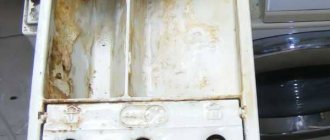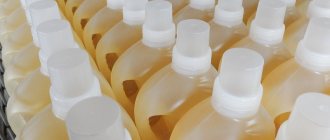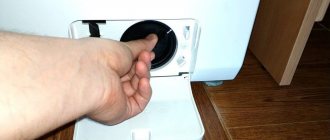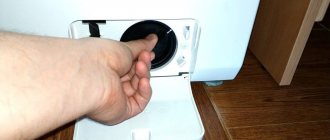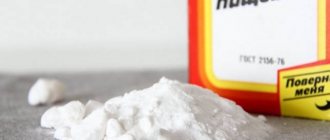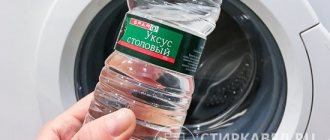Most modern housewives simply cannot imagine their lives without an automatic washing machine, which saves energy and time, greatly facilitating everyday household chores. However, not all of them know that a home assistant also needs regular care. And this should not be limited to wiping dust from the body, washing the detergent tray and adding anti-scale preparations. From time to time, much more extensive cleaning of the entire machine is required.
How to clean a washing machine
If this activity is not carried out periodically, the quality of washing clothes will decrease significantly over time, mold will appear on some parts of the appliance, and an unpleasant odor will begin to emanate from the drum. In order not to bring the situation to such a neglected state, it is necessary to regularly wash all the chambers of the machine.
Therefore, the question of how to clean a washing machine should be of interest to any owner. Moreover, in addition to the means offered by industry, there are more accessible, economical ways to restore proper order.
How to clean the drum
- Pour 100 ml of chlorine bleach into the machine drum and start the wash at a temperature of at least 60 °C. Without underwear, of course.
- You can use citric acid to remove scale. Pour 100 g into the drum and run the wash at maximum temperature. Ideally, the mode will include double rinsing. Then the plaque will be removed 100%.
- Mix a small amount of water and soda in a 1:1 ratio and pour the solution into the detergent compartment. Pour a little vinegar into the drum itself: no more than 400 ml. Set the temperature to maximum and let the machine do almost all the work for you. Then remove any remaining dirt with a sponge and wipe the drum dry. Plaque, mold and unpleasant odor will disappear without a trace.
Procedure for comprehensive cleaning
In addition to scale, there are other problems that can be caused by improper operation of the machine: dirt, unpleasant odor, mold. Therefore, you should regularly maintain the cleanliness of the internal elements.
Step #1 - wash the drum
After each wash, residual water and dirt remain in the drum. And soon black spots appear in the folds of the sealing cuff, and a musty smell comes from the depths of the machine.
Starting at idle speed with the addition of disinfectants or regular citric acid will help solve the odor issue. But the gum needs to be thoroughly cleaned by hand.
To clean the cuff, it is not recommended to use aggressive chemicals containing chlorine - such chemicals can make the rubber “hard” and quickly crack.
The easiest option is to carefully push the folds apart, wash the cuff around the circumference with a sponge, soap and warm water, and then wipe dry.
If you notice mold stains, you can use a solution of copper sulfate or prepare a cleaning paste of water and baking soda in equal proportions.
Then thoroughly treat the elastic band and the entire drum with this mixture, leave for a couple of hours, and then wipe with a sponge and start the long-term wash cycle.
For more information on cleaning your washing machine drum, see this article.
Step #2 - clean the filter and drain hose
The cause of an unpleasant odor can also be debris invisible to the eye - hair, particles of soil or building materials, lint, feathers and various small objects that were not removed from clothing pockets in time.
All this accumulates in the filter and hose through which the machine releases waste water. It is recommended to clean the washing machine drain filter at least once every 3 months, and more often during active use.
To do this, you need to remove the protective panel, place a small container for draining water or place a rag on the floor. Then unscrew counterclockwise and remove the filter. Rinse it under high pressure water and remove accumulated debris from the hole.
Typically the filter is located in one of the lower corners of the front of the panel and is covered with a small round or rectangular plate that can be easily pryed off with a flat-head screwdriver
To rinse the hose, you need to drain the remaining water in the machine through the drain filter and then disconnect it from the entrance to the sewer pipe or siphon. After this, you can remove the part, but exactly how to do this depends on the design of the device itself.
Ariston , Samsung , Indesit , Whirpool , Ardo machines you can only get to the hose connection through the bottom.
To do this, you need to lay the device on its side, remove the bottom panel and filter, and loosen the clamp with pliers. All that remains is to disconnect the pump and remove the hose itself.
Before disconnecting the hose, be sure to disconnect the device from the electrical network and turn off the water supply tap (if there is no separate one for the machine, then the apartment one)
In Electrolux and Zanussi you need to look for the drain fastening behind the rear panel, and in Bosch and Siemens - behind the front, when it comes to front-loading machines.
But for vertical models, you can only get to the hose through the side cover. Therefore, it will not be superfluous to check the instructions, which describe the device diagram.
To clean the drainage hose from dirt and powder deposits, equip yourself with a thin non-metallic cable with a mini brush attached to one end.
We run this brush inside, scroll it and gradually move it to the end of the hose. Then rinse under pressure of warm water. For severe contamination, several passes can be made.
Step #3 - wash the powder container
A rough coating from hard water appears on the walls of the detergent compartment, and traces of powder and various rinse aids remain. All this needs to be removed.
If the remnants of detergents are quite easily removed with warm water and a sponge, then limescale or mold will have to be fought
We act in stages:
- We remove the cuvette from the compartment and remove the container for the conditioner.
- We rinse under running water, wipe off mold stains with soda or any chlorine-containing product (there are no rubber elements here, so chlorine will not harm).
- Pour a packet of citric acid into a small bowl.
- Place the disassembled cuvette, fill it with hot water and leave for an hour (if it is heavily soiled, it can be overnight).
- Then we remove the remaining plaque with a sponge and thoroughly clean all joints with a toothbrush.
- Dry the container, assemble and place in place.
Another option for dealing with plaque is to fill the removed cuvette with soda and add table vinegar. As a result of the reaction, the soda will foam and soften the lime deposits so that they are easier to remove.
In addition to the container itself, the powder receptacle itself also requires cleaning, and there are many hard-to-reach places with various recesses and small parts
To get rid of dirt and plaque in the container compartment, you can use the same soda paste and toothbrush, and pre-treating the tray with a spray cleaner will help speed up the process.
How to descale heating elements
- Citric acid will again help get rid of scale on the electric heater. The amount of powder depends on the degree of soiling, but on average, a machine with a 5 kg load requires 250 g. Pour 200 g into the powder compartment, and 50 into the drum and run the wash at maximum temperature.
- More aggressive acetic acid can also deal with scale. Just add 50 ml of vinegar to the conditioner container and turn on the machine. Be careful: vinegar can damage the rubber elements.
We remove scale from the heating element and internal elements
One of the most serious accidents that can easily happen if you do not properly care for your washing machine is the failure of a tubular electric heater.
A failed heating element can block the operation of the machine both at the initial stage (the selected mode simply cannot be started) and stop the washing process in full swing
Since the heating element is in contact with running water, scale forms on it after each wash - deposits of calcium and magnesium salts.
Therefore, if a softening filter is not installed in the drain, it is recommended to add special agents to the powder (for example, Calgon ) and carry out preventive maintenance at least once a month.
Method #1 - improvised materials from stocks
One of the simplest and most effective ways to combat lime deposits is to pour tribasic carboxylic or citric acid into the powder compartment and turn it on at any high temperature setting.
This recipe works simply: when heated, the acid actively corrodes not only light deposits, but also caked limestone, as a result of which it cleans both the heating element and the steel of the drum.
Never combine the cleaning process with washing things - even home remedies like baking soda or vinegar solution (not to mention citric acid) can cause irreparable damage to fabrics
Calculation of the required amount of powder must be done based on the degree of contamination of the machine and its container. On average, for every kilogram of loading there is about 25-30 grams of acid.
If the unit has not been cleaned for a long time, you can take note of the following advice: pour acid into the powder container, run any long washing mode with a temperature of 90°C and above and turn off the power from the network halfway through the process. Leave it overnight and start the machine again in the morning.
Citric acid can be poured directly into the drum, but it’s better to put it in the detergent compartment to clean it at the same time
It is recommended to use this procedure no more than 4 times a year, and after each time you must check the drain hose and drum cuff to remove large particles of loose limestone.
Other home remedies and their uses:
- Table vinegar - pour 1-2 cups of a 9 percent acetic acid solution into the detergent cuvette, select a high-temperature mode with long washing and pre-soaking. To get rid of the specific sour smell, you can then turn on an additional rinse.
- Baking soda and vinegar - to enhance the effect of acid on limescale, a special solution will be useful. It is prepared like this: half a glass of soda is mixed with the same amount of water and placed in a container for powder, and 1 glass of 9% vinegar is poured into the drum. Then the machine starts in any long-term mode at maximum temperature.
- Bleach and other chlorine -containing products are used in the old fashioned way by many housewives for comprehensive cleaning and disinfection of the washing machine.
But in fact, the effectiveness of caustic preparations is very doubtful: they will not save you from scale, but some elements (for example, the rubber drum seal and various sealing gaskets) can cause great damage. And chlorine vapors are harmful to health.
There are also more innovative “recipes” for cleaning a washing machine, for example, pour 5-6 liters of Coca-Cola into the tank and leave for a couple of hours
But we looked at the most reliable, cheap, safe and practice-tested methods for getting rid of scale using improvised means.
Method #2 - special chemicals
The cleaning agent for washing machine elements must be safe for humans, fabrics and all internal surfaces of the device, and also effectively remove lime deposits and other contaminants.
Specialized preparations have an important advantage over “folk” ones - their composition is developed taking into account the design features of the device and does not harm some elements while cleaning others.
To buy the right “chemistry” to solve the desired problem, always study the composition and purpose of the drug - there are both universal products for complex cleaning, and narrow-profile ones that only work to remove plaque or fight mold
Review of popular specialized products:
- Topperr 3004 (Germany) – descaling cleaner, suitable for dishwashers and washing machines. It removes scale of varying degrees well, recommended by Bosh manufacturers.
- Schnell Entkalker is a powder for quickly cleaning internal elements from stubborn lime deposits. Produced in Germany, available in 200g packs.
- Antikalk for Washing Machines from Sano (Israel) is a universal gel for the prevention and elimination of small plaque with an antibacterial effect.
- Magic Power (Germany) is one of the best specialized products for washing machines. Available in the form of gel and powder, which effectively removes plaque from heating elements, tanks, and drums.
- Beckmann (Germany) is a universal product that will protect against scale and eliminate unpleasant odors caused by various contaminants. But, like any multi-purpose product, it is good for regular care, but will be ineffective against heavy dirt.
- Filtero 601 (Germany) – works well to remove old scale from the heater and other elements; it is recommended to use 3-4 times a year for intensive cleaning of the machine. Available in 200 g bags for one use.
- Doctor TEN (Russia) and Antinakipin (Belarus) are analogue powder preparations intended only for removing scale, but from any equipment. An inexpensive and convenient solution to the problem of lime deposits on the heating elements of both washing machines and dishwashers.
Please note that many products that, judging by the advertising, are guaranteed to protect our machine from problems with plaque, will not get rid of existing scale, but will simply reduce the concentration of salts in the water, for example, the same Calgon .
It is easy to distinguish between them - it is recommended to add such preparations before starting the machine along with the powder or directly into the drum, and they are used when washing things.
Method #3 - manual cleaning
If you have never thought about how to clean your washing machine and all its key elements before, and the assistant has served you for more than one year, it is recommended that you first carry out a visual inspection of the heating element.
Most likely, a multi-layered limestone has already formed on the heating element, which will be easier to remove manually - with standard cleaning methods, broken-off solid plaque particles may remain inside the unit.
You should not try to scrape off the stone with a knife or other sharp objects - you can damage the coating or even break the heating element; it is better to place the heating element in a solution with citric acid or a professional descaling agent
To clean the heating element we proceed in stages:
- Disconnect the wires, sensor and remove the heating element . Scale and dirt can interfere with the process, so after loosening the fastening, carefully pry up the metal flange with a flat-head screwdriver. But be careful and proceed smoothly so as not to damage the tank itself and the wiring.
- We rinse the heating element under good pressure with warm water to remove loose deposits and dirt.
- We make a concentrated solution to remove stone residues: pour 3-4 tbsp into a plastic bottle with a cut off neck. citric acid powder, place the heating element inside and fill with hot water to the level of the bar.
- Shake the liquid to activate the cleaning process . Rising air bubbles will indicate that magnesium and calcium salts have begun to dissolve.
In this state, we leave the heating element to soak overnight. And in the morning, we rinse the metal under running water with a soft sponge, wipe it dry, admire the glare of light on the sparkling stainless steel and install the element back into the device.
The heater is always located under the tank, but its specific location depends on the brand of the device, for example, in LG, Ariston and Indesit you need to remove the back panel to remove it, and in Samsung and Bosh you need to disassemble the front
By the way, if you take the machine apart, you can also inspect the condition of the drum. You may have to dismantle it too in order to thoroughly clean all the holes and remove scale and mold.
But you shouldn’t do this without extreme necessity and skills in working with equipment; you can get by with treatment with a good special tool.
How to Clean a Drain Hose
When you clean the drum with baking soda and vinegar, the drain hose is also cleaned. But if a serious blockage occurs, additional measures must be taken.
Unplug the washing machine and turn off the water supply. Disconnect the hose from the machine (water may spill out during the process, so do not forget to substitute a container).
Now you can start cleaning. For it they use a Kevlar cable with a non-metallic (!) brush at the end. First clean the hose on one side, then the other, and finally rinse it under running hot water.
Preventive actions
You can give a few more recommendations, if followed, the washing machine will serve you for a long time:
- If the region where the device is used has very hard water, then regular washing soda should be added to the powder with each wash. You will need a little of it, one tablespoon is enough. This product will soften the water, preventing the formation of lime deposits. The cost of soda is low, and the effect is very good.
- Once or twice a year you can clean it with citric acid.
- If you have hard water, it is recommended to install additional softening and purifying filters in the water supply system - this will be useful for all plumbing household appliances, and for the health of the owners too.
- For washing, it is recommended to use powders or gels, which by default already contain softening agents. True, high-quality products of this type always cost much more.
- Using Calgon with each wash will rid the machine of lime deposits - this is how manufacturers position this product. However, the price for this composition is quite high. By the way, regular use of the washing soda already mentioned above gives approximately the same effect, but is much cheaper.
- It is recommended not to overuse washing at high temperatures.
When purchasing a washing machine, it is recommended to give preference to a model with a ceramic water heater. This material and its smooth surface are covered with scale much longer and are more resistant to aggressive cleaning compounds.
Find out how to replace the heating element in a HANSA washing machine with step-by-step instructions.
* * * * * * *
So, if you follow the recommendations, owners can keep their washing machine in working order for many years, without the need for repairs. Therefore, the performance of the device largely depends on the regularity of preventive maintenance and constant monitoring by the owners.
Let’s finish this publication with a video in which the owner of a washing machine shares her secrets of regularly cleaning it.
How to Clean a Top Loading Washing Machine
Cleaning is carried out at the highest temperature. First, pour 2-3 cups of vinegar into the water and let the machine stir the solution for a couple of minutes.
Then add half a cup of baking soda. Allow the ingredients to react, then turn off the appliance and leave it to soak. This will take from 30 minutes to an hour.
While the insides of the machine are being cleaned, take care of the rest of its parts. Mix vinegar and water in a 1:1 ratio and wipe the surface of the device with the solution, clean the powder compartment.
When the machine gets wet, resume washing. Wait until all the water has drained and use a sponge to remove any remaining dirt.
Cleaning the removable powder tray from detergents
Over time, dirt, mold and even mildew form on the surface of the tray. During the washing process, all this comes into contact with the drum and our laundry. Cleaning the container is easy as it can be removed from the washing machine.
We will need an old toothbrush, soap and toilet cleaner. Dirt and mold can be removed with a brush and soap. To remove plaque, use a toilet bowl cleaner. Pour 20–30 ml into the compartment and leave for 1–2 hours. The procedure is simple, so you can repeat it after every 5th wash.
Recommendations for caring for your washing machine
To keep your car clean for as long as possible, try to follow these tips:
- Don't use too much powder. Excess detergent may accumulate inside the machine.
- Remove heavy soiling from clothing before washing.
- Use special anti-scale products.
- Leave the door open after washing. This will reduce the risk of fungus formation.
- From time to time, run the empty machine at maximum temperature. Hot water itself does a good job of removing minor stains.
Do you know other ways to easily clean your washing machine? Share them in the comments.
Causes of pollution and their possible consequences
First, let’s make sure that cleaning is a forced and necessary action. And it doesn’t hurt to know what exactly needs to be cleaned. Let's take a look inside the machine, which has worked for quite a long time. It is highly likely that we will see a dirty coating on the surface of plastic and metal parts. It can be hard and contain minerals, so you can’t handle it with a rag or your hands.
The reasons for this problem may be the following:
The water coming from the tap is hard or dirty.
The powder contains too many chemical components.
The machine constantly operates in the “intensive wash” mode.
What’s especially bad is that many of the corners where dirt accumulates are difficult to reach. Try to clean them - your hand won’t fit there, and poking with something sharp is too dangerous. So more and more dirt accumulates, and then the machine can’t stand it and breaks down. And repairs cost a pretty penny. So why go to such extremes - it’s better to ask in advance how to clean the drum of the washing machine, its tank and heating element. By taking timely measures, you can significantly extend the life of the device.
Why does scale form?
When water is too hard, it is full of calcium and magnesium salts. When heated, they are converted into carbon dioxide and solid sediment, which, together with dirty particles (for example, pieces of rust), remains on the heating element and the tank of the washing machine. When covered with a crust of scale, the metal heating element conducts heat worse. Result: water takes longer to heat up, more electricity is required. And dirt from the water also does its dirty work - it clogs the inlet valve, the parts of which wear out ahead of time.
Important: maximum dirt and debris penetrates into the machine after repairs or turning off the water.
You can find out whether there is scale on the heating element or not yourself. Usually the heating element is located directly under the drum, or is slightly offset relative to its center to one side. Taking a flashlight, direct its beam at the holes in the drum, trying to see the heating element. At the same time, shake the drum slightly so that the lighting is uniform. Often this is not possible right away - you have to experiment a little with the speed of swinging.
Washing machine heating element with huge salt deposits.
Chemicals for descaling
To choose a descaler for washing machines, you need to study the whole variety of professional chemistry. The following drugs have proven themselves to be excellent:
- Bubble Ice powder, liquid Astonish, Filtero.
- Antiscale is poured into the drum, after which the longest-term program is launched. The downside is that if the dosage is exceeded, parts of the machine may be damaged, and the seals will begin to leak. In the process, acid evaporates, which can also negatively affect the health of household members.
- Calgon contains sodium polyphosphate, which reduces the hardness of tap water, which reduces the degree of lime accumulation on the heating element. However, it should be remembered that this remedy cannot eliminate already built-up calcium-magnesium deposits. It has been noticed that after long-term use of Calgon, the service life of the machine only decreases. We have already written about how to replace calgon here.
- Magic Power is a product from Germany that has established itself as one of the best products for cleaning all hard-to-reach equipment parts.
- Luxus Professional is successfully used to clean limescale deposits not only from automatic machines, but also from irons, kettles and other equipment. After it, all equipment has a light lemon aroma. You should strictly adhere to the dosage and instructions for use.
- Top House - suitable for any appliances, successfully removing scale. 1 jar is enough for 5 cleaning procedures.
- Among budgetary, but less effective means, we note Topper 3004, Bork K&P, Breeze, etc.
Mechanical cleaning
If you don’t want to clean your machine with folk remedies and household chemicals, then mechanical action will help to effectively remove plaque from the internal parts. What is the advantage of this method?
- If the part is removed and you clean it outside the machine, then there is no risk that large pieces of scale will not dissolve and will remain inside.
- During the dismantling process, you can at the same time check the parts, determine the degree of wear and possible malfunctions. We advise you to change the rubber seals that do not cope with their assigned functions during each disassembly.
- After mechanical exposure, you can use homemade cleaning methods: usually lemon juice or vinegar.
Prevention
Simple prevention methods will help you avoid the formation of persistent plaque:
- It is known that salt particles in hard water crystallize at temperatures above 750. This means that those washing programs in which the water will not heat up above 700 will help reduce the risk of scale formation on the heating element.
- Magnetic water filters will help both washing equipment and its owners. A smart device will make the water less hard, which will benefit the health of apartment residents, while keeping the machine parts clean.
- From time to time it is worth carrying out preventive cleaning. Frequency – every 6 months. For hard water, prevention is recommended at least once every two months.
- Saving on powder is a false economy. Harmful compounds contained in laundry detergents negatively affect the condition of the heating element. It is better to choose a special powder with a softening element.
- The simplest rules will help keep the device in proper condition: do not leave wet laundry in the drum, after washing, wipe the inside with a dry cloth, and periodically ventilate the machine.
Causes of plaque formation
As you know, tap water contains a small amount of foreign impurities and inorganic salts, which include calcium and magnesium ions. It is the concentration of the latter that determines the degree of water hardness. When heated, these salts decompose, forming carbon dioxide and insoluble calcium (magnesium) deposits. These deposits actively settle on the walls of the heating elements, forming scale. The thermal conductivity of scale is significantly less than the thermal conductivity of metal. This means that the appearance of an unwanted thermal insulation film forces the electric heater to increase its power to heat the water to the usual temperature, which can lead to failure of the element.
Even mineral water, freshly extracted from wells, already contains metallic impurities. The thing is that on the way of its movement underground, water comes into contact with metal-containing ores and dissolves the substances contained in them. This is why even refusing to use tap water will not help avoid the appearance of insoluble sediment.
Reviews
Maria, 25 years old, Orenburg
I regularly clean my car with lemon juice 2 times a month at 40 degrees. The best remedy! I don’t notice any problems in my work; on the contrary, everything is clean, without scale or mold.
Arina, 38 years old, Nizhny Tagil
I clean my car with vinegar. It seems to me that the effect is the same. It’s just not a problem to find vinegar at home; it’s rarely used anyway, but you’ll have to go to the store for citric acid.
Lyubov, 56 years old, Moscow region.
I buy citric acid in bulk at a baking store, it turns out much more profitable. After finishing the wash, I run the rinse mode a couple more times, this makes it easier to remove all the accumulated debris.
Igor, 27 years old, Irkutsk
We cleaned our machine several times, and to be safe, we filled almost the entire compartment with acid. A year later, the machine began to hum and rumble strangely. Later they realized that they had overdone it with the volumes. Now we only use Calgon and are categorically against traditional recipes.
Why descale?
An automatic washing machine is an expensive home appliance. The owners strive to extend its service life.
First of all, tap water, which contains a lot of metal salts, rust and other pollutants, harms the machine.
Washing powders, pastes, and gels make their contribution, gradually settling on the parts and forming an extremely durable layer. For this reason, measures are periodically taken to remove scale from the washing machine.
Scale does not conduct heat easily. This increases the intensity of work, parts overheat and fail faster. To maintain performance, you should clean the washing machine from scale and other dirt, including mold.
Use of special chemicals
Here's how to descale your washing machine using ready-made chemicals from the anti-scale range. The acid included in the composition reacts with metal salts, dissolving deposits.
Before descaling the washing machine, pour cleaning compounds into it and turn on the mode at the temperature recommended by the manufacturer. Linen is not loaded. One cycle is enough for cleansing.
If, when descaling the washing machine, you overdo it with the amount of aggressive agents, the rubber parts may become deformed. A leak will open and the unit will have to be repaired. It is important to follow the instructions.
When deposits appear, the automatic washing machine should be cleaned using chemical cleaning agents once every six months. If necessary, between treatments with ready-made formulations, use gentle preparations from the treasury of folk wisdom.
Ready-made preparations are easy to use. Powdered ones are packaged for single use. To descale your washing machine, place the contents of one sachet in an empty drum. Then the machine washes at a preset mode.
We recommend reading: The effect is obvious: after cleaning using the chosen method, the silver chain will become like new
Before descaling a washing machine, study the range on offer. Among the powdered products, the popular brands are Furman and Greenfield.
You can clean the unit using liquid anti-scale agent Cinderella. When deciding how to remove scale from a washing machine, take two caps of the concentrated product, dilute it with a glass of water and pour it into an empty drum before washing. Turn on intensive rotation mode with a set temperature of 40 °C.
When using chemicals that soften and remove scale in an automatic washing machine, wear rubber gloves. This will prevent chemical burns if the product gets on your skin. To prevent the powdered drug from damaging the respiratory organs, protect the nose and mouth with a mask. If the product accidentally gets into the eyes or mucous membranes, they are immediately washed with water.
Household chemicals
The chemical industry offers a considerable selection of cleaning products for automatic machines. The use of such reagents greatly simplifies the maintenance of the device and extends its service life.
Most of them are designed to remove scale and salt deposits: Magic Power, Refine, Luxus Professional, Doctor Ten, Bagi Avnit. There are also universal ones that cope with a range of problems (scale, odor, mold): Tiret, Nagara, Dr. Beckmann.
But it is worth considering that the cost of such funds is not small. In addition, manual cleaning of the tray, filters and cuff will still not cancel it.


